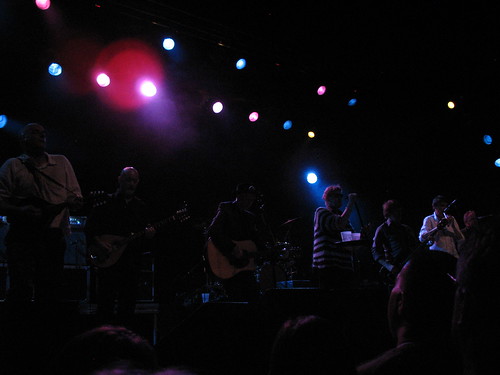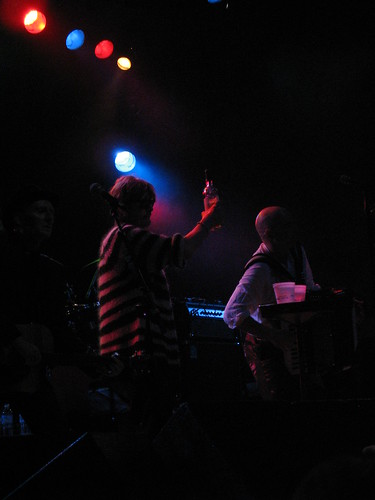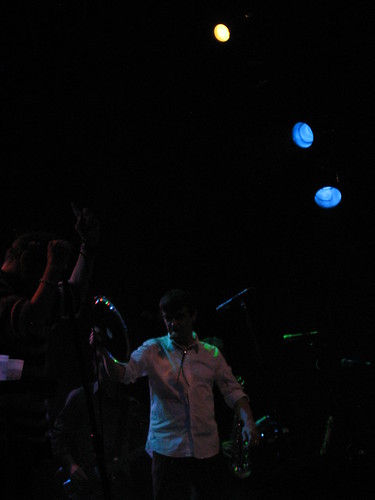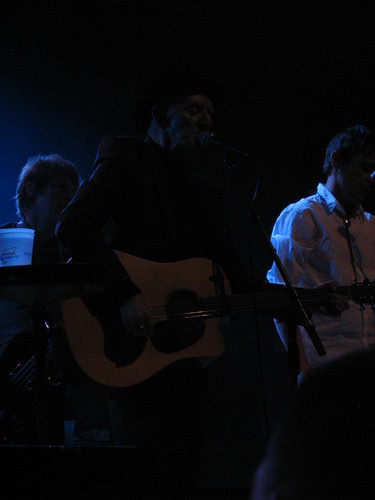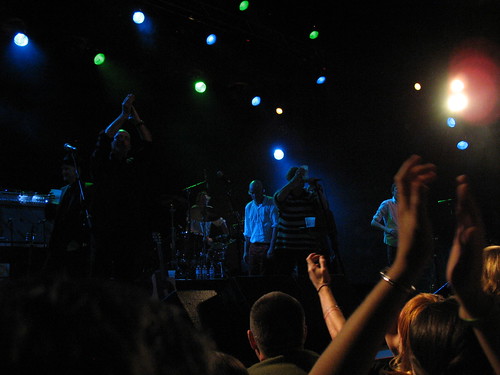Welcome to SILENT FILM WEEK! All silents, all the time. No talkies here, nosirree.
Okay, that's not entirely true. I also watched Persepolis - but that was a movie club pick, so not my fault.
Then I watched the Diving Bell and the Butterfly. Just because. But I still watched five silents, so I'm still calling this SILENT FILM WEEK! Let's begin, shall we?
Bronenosets Potyomkin (Battleship Potemkin)
Sergei Eisenstein, 1925
 Fed up with eating maggoty meat, the crew of the Potemkin rise up against their captain, which inspires the rest of Russia to do the same.
Fed up with eating maggoty meat, the crew of the Potemkin rise up against their captain, which inspires the rest of Russia to do the same.I’ll say it here, and I’m sure I’m not the first: Odessa Steps. The massacre on the Odessa Steps is such a towering achievement, such an incredible and influential sequence, that it renders the rest of the movie kind of redundant. After all, it’s really not much of a story. Even those who laud it tend to view the plot as cartoonishly simple, at best. The lack of characters contributes to this – There are very few identifiable individuals. After the half hour mark, I don’t think anyone even has a name. This is clearly a deliberate choice, and a perfectly legitimate one – the movie is about the uprising of the proletariat, as a collective force. Focusing on individuals would undermine that. At the same time, though, it doesn’t leave much to focus on or develop. No, the pleasures of Potemkin lie purely in the details – Eisenstein’s sense of rhythm and editing skill, his innovative use of montage – or, to put it simply, everything that is on display on the Odessa Steps. Sadly, this also means you wind up with a movie that is more important than it is watchable.
5.5/10
Chelovek s kino-apparatom (Man with a Movie Camera)
Dziga Vertov, 1929
 Plot? We don’t need no steeeenking plot.
Plot? We don’t need no steeeenking plot. It does not inspire confidence when a movie starts off with several pages of text explaining that it’s a little different from other movies, because they’re all soooo conventional and it’s time to break free of blah, blah, blah.
Fortunately, my apprehension was somewhat misplaced, as Man with a Movie Camera is actually quite good. Granted, it suffers from the lack of plot and characters – my feeling is that the beauty of film is that it’s a composite art form, which takes elements of theater, literature, photography, etc. . . and if you deliberately set out to exclude some of those elements, you are ignoring your full potential. But it’s hard to be too upset about that limitation when what the things that do wind up on screen are just so. . ..neat. From slice-of life scenes of contemporary Russia to strange stop-motion sequences to a trip inside the editing room, where this very movie is being created, Vertov manages to keep the imagery novel throughout the running time. If there is anything that resembles a plot or a through-line, it’s Vertov’s continual focus on the movie as an element of itself (ooh, how meta!). We are repeatedly shown footage of cameramen recording the footage that we see immediately before or after, and the titular man with a movie camera is frequently composited into shots as a sort of supernatural, almost god-like being. Then there’s the afore-mentioned visits to the editing room, which capture the sense of a movie being created from the inside better than anything else. I’ve ever seen.
I’m starting to sound more enthusiastic about this movie than I really am. That’s bound to happen, the more I get into the details of the piece. Ultimately, though, I don’t think Vertov’s experiment was entirely successful. Sixty-eight minutes is a long time to go without something to focus on, and by the end, it’s hard to be certain what was really accomplished. It’s important that the effort was made, though, because this is sort of experimentation is what ultimately lead to modern film. And even as (partial) failures go, it’s a very enjoyable and interesting one.
7/10
The Son of the SheikGeorge Fitzmaurice, 1926
 Ahmed (Rudolph Valentino), the son of the Sheik (Valentino again), falls in love with Yasmin (Vilma Banky), a dancer. Her father and his associates rob and torture Ahmed, who mistakenly believes that Yasmin lured him into a trap. He kidnaps her in order to exact revenge.
Ahmed (Rudolph Valentino), the son of the Sheik (Valentino again), falls in love with Yasmin (Vilma Banky), a dancer. Her father and his associates rob and torture Ahmed, who mistakenly believes that Yasmin lured him into a trap. He kidnaps her in order to exact revenge.This one didn’t really work for me. Part of that is the odd story, which progresses in fits and starts and skips over important parts (like Ahmed and Yasmin’s initial budding romance). Part of it is the generally cheap look – there’s some great desert photography, but most of the movie takes place on a few small-ish sets. Mostly, though, I just don’t but Rudolph Valentino in the lead. He looks like a petulant high-schooler and can’t seem to move any part of his face very much except for his eyebrows, which go into overdrive to compensate. He’s a total screen presence vacuum, and wanders through most of the movie relying on his friends/bodyguards/enforcers for the muscle to turn his whiney requests into action. Less of a leading man, more of a captain of the football team. You know, the douchey one that everyone hated. The kind that would kidnap a girl and rape her (that’s what it looks like, anyway) as revenge for a betrayal. I’m talking about Ahmed, not (necessarily) the football captain on that last point.
On the other hand, though, once they slap some old-age makeup and a fake beard on him to play the Sheik, it’s a whole different story. Suddenly there’s a touch of gravitas. I thought for a moment that maybe the filmmakers were engaging in a bit of misdirection, and that Ahmed was turning out to be such a little turd because the Sheik was going to step in and be the true hero of the story. Alas, this was not to be – The Sheik remains tangential to the plot, providing little more than an opportunity for some (admittedly very impressive) split-screen shots and a helping hand in the fight scenes. So we’re left with Ahmed as our hero. I think I might have preferred a movie about Ahmed’s friend/bodyguard, who looked like a cartoon rendition of
Jayne Cobb and loved to strangle things. He was certainly the most memorable thing about the movie.
3/10
PersepolisMarjane Satrapi and
Vincent Paronnaud, 2007
 The animated story of Marjane Satrapi’s (Gabrielle Lopes Benites and Chiara Mastroianni) childhood and teen years growing up in Iran and Vienna.
The animated story of Marjane Satrapi’s (Gabrielle Lopes Benites and Chiara Mastroianni) childhood and teen years growing up in Iran and Vienna.Persepolis features simplistic but beautiful hand-drawn animation, which does a lot to add interest to what is, ultimately, a fairly standard biographical tale. This is not to say that the story itself is completely uninteresting, but the animation gives it a more expressionistic feel, which in turn provides a more direct view of how Marjane thought and felt about the events portrayed. The details are better able to come to the fore, and it comes to life in a way that a live-action version, for instance, would not. After all, in basic terms, what really happens? Marjane grows disgusted with Iranian culture and leaves for the west, is unable to cope with life there, returns to Iran, is unable to accept life in Iran (again), and finally moves to Paris. Not much there. But when you start throwing in bread swans and snake-like nuns and magically transforming memories of her boyfriend in Vienna, you start to have something.
I suppose I should also mention that it’s quite funny in a lot of places, and how nice it is that Marjane is so not-idealized. What I’m ultimately saying is that the story may not have much drive, but the telling of the story goes a long way toward making up for that. And the animation isn’t the only part of that telling that helps. It’s just the most important part.
7/10
The ShockLambert Hillyer, 1923
 Wilse Dillman (Lon Chaney), a crippled, cold-hearted hitman, is hired to stake out a small-town banker (William Welsh). He falls in love with the banker’s daughter (Virginia Valli), turns over a new leaf, and decides to defend them against his former employer. Earthquakes ensue.
Wilse Dillman (Lon Chaney), a crippled, cold-hearted hitman, is hired to stake out a small-town banker (William Welsh). He falls in love with the banker’s daughter (Virginia Valli), turns over a new leaf, and decides to defend them against his former employer. Earthquakes ensue.This movie has one thing going for it, and that’s Lon Chaney. He’s a strong actor and always interesting to watch, even if the script doesn’t provide him much support – and this one doesn’t. Key stretches are skipped over (like Dillman’s conversion from evil to good) and there’s an extremely heavy over-reliance on title cards to tell the story. Their frequent use, great length, and ridiculously florid language make the whole thing feel more like a moving picture book than a movie. Other than Chaney, the only thing of interest throughout most of the running time is the occasional bit of bizarre hilarity, such as the scene in which a doctor, emerging from the room in which he is tending to the banker’s daughter, who was recently caught in an explosion, walks straight up to her fiancée and says “you better call it off, son. It’s not looking as pretty as it did.” Hell of a doctor.
Things do pick up in the second half, when Dillman must infiltrate the criminal underworld to steal some incriminating documents. This material plays out much more smoothly, with far fewer intertitle summaries, and the difference compared to the first half of the movie is night and day. Unfortunately, it all leads up to nothing, as our heroes are saved by a fortuitous earthquake. Yes, you read that right. Even the movie itself has to throw in the suggestion (without committing fully to the idea) that it was a response to Dillman’s prayers because there’s no other even remotely dramatically satisfying way to justify it. To make matters worse, the earthquake doesn’t just give Dillman an opening to turn the tables – it just kills the bad guys and saves the good guys. We have earthquake, we have brief romantic coda, and we’re done. The plot completely disengages from the characters.
At least Chaney got the girl this time.
2.5/10
Le Scaphandre et le Papillon (The Diving Bell and the Butterfly)
Julian Schnabel, 2007
 Jean-Dominique Bauby (Mathieu Amalric) struggles to find meaning in life after a stroke leaves him paralyzed and only able to communicate by blinking his left eye.
Jean-Dominique Bauby (Mathieu Amalric) struggles to find meaning in life after a stroke leaves him paralyzed and only able to communicate by blinking his left eye.I liked it quite a bit, particularly the technical aspects. Had some trouble telling several of the female characters apart, which is strange. Unfortunately, I wound up watching the English dubbed version instead of the original French, but at least most of the actors dubbed themselves. For some reason, I don’t feel like I have a lot to say about it. But it was good.
8/10
La Chute de la Maison Usher (The Fall of the House of Usher)
Jean Epstein, 1928
 Sickly Madeleine Usher (Marguerite Gance) dies just as her husband Roderick (Jean Debucourt) finishes painting her portrait. Or does she?
Sickly Madeleine Usher (Marguerite Gance) dies just as her husband Roderick (Jean Debucourt) finishes painting her portrait. Or does she?While a fairly poor adaptation of Poe’s story (what’s this husband/wife nonsense?), Epstein’s version of Usher is a terrific piece when considered on its own terms. The visual design is a bizarre mix of the abstract and impressionistic, with light bulbs serving as stars in the sky and a very Caligari-esque mausoleum, and the more realistic but still otherworldly interiors of the Usher mansion, which are cavernous open spaces that stand mostly empty with only a few small pieces of furniture. Debucourt’s Usher is at times terrifying to look at – insane, but with a strange childishness that makes it very creepy. Watch for the way his eyes glaze over near the end, as he awaits Madeleine’s return. I think he even surpasses the great
Vincent Price in the role. Of course, he’s helped by Epstein’s innovative camera tricks, including extreme close-ups, double and triple exposures, and even something that looked almost like a
snorricam.
The (sadly OOP) DVD features an interesting translation as well. Rather than replace the French intertitles, which are hand-drawn and very striking, with English ones, or subtitle the intertitle screens, the producers have opted to have an actor read the titles in English when they appear. A sort of inverse subtitle, you might say. It’s actually quite effective, both in keeping the audience off-balance (that’s not how you present translations!) and in establishing a fantastic, storybook sort of mood. The score, produced in 1990 and featuring medieval orchestration, is fantastic as well. If the damn thing wasn’t out of print, I would absolutely be adding it to my collection.
8.5/10
Progress: 84 (Par +14)
 Joan of Arc (Maria Falconetti) is interrogated, tortured, and burned at the stake.
Joan of Arc (Maria Falconetti) is interrogated, tortured, and burned at the stake. A projectionist (Keaton) is accused of stealing his girlfriend’s father’s watch in order to buy her a box of chocolates. He tries and fails to catch the real thief, then dreams himself into a movie where he becomes the famous detective, Sherlock Jr.
A projectionist (Keaton) is accused of stealing his girlfriend’s father’s watch in order to buy her a box of chocolates. He tries and fails to catch the real thief, then dreams himself into a movie where he becomes the famous detective, Sherlock Jr. Robin Hood (Errol Flynn) steals from the rich to give to the poor, falls in love with Maid Marian (Olivia de Havilland), and generally makes himself a nuisance to Prince John (Claude Rains)
Robin Hood (Errol Flynn) steals from the rich to give to the poor, falls in love with Maid Marian (Olivia de Havilland), and generally makes himself a nuisance to Prince John (Claude Rains) Willie McKay (Keaton) travels back home to the south to claim his father’s estate. On the way, he meets and falls in love with Virginia Canfield (Natalie Talmadge) – which is a problem, because her father and brothers have sworn to kill every last member of the McKay family.
Willie McKay (Keaton) travels back home to the south to claim his father’s estate. On the way, he meets and falls in love with Virginia Canfield (Natalie Talmadge) – which is a problem, because her father and brothers have sworn to kill every last member of the McKay family.  Two would-be criminals (Sami Frey and Claude Brasseur) convince a naïve young girl (Anna Karina) to help them rob her aunt’s house.
Two would-be criminals (Sami Frey and Claude Brasseur) convince a naïve young girl (Anna Karina) to help them rob her aunt’s house.






